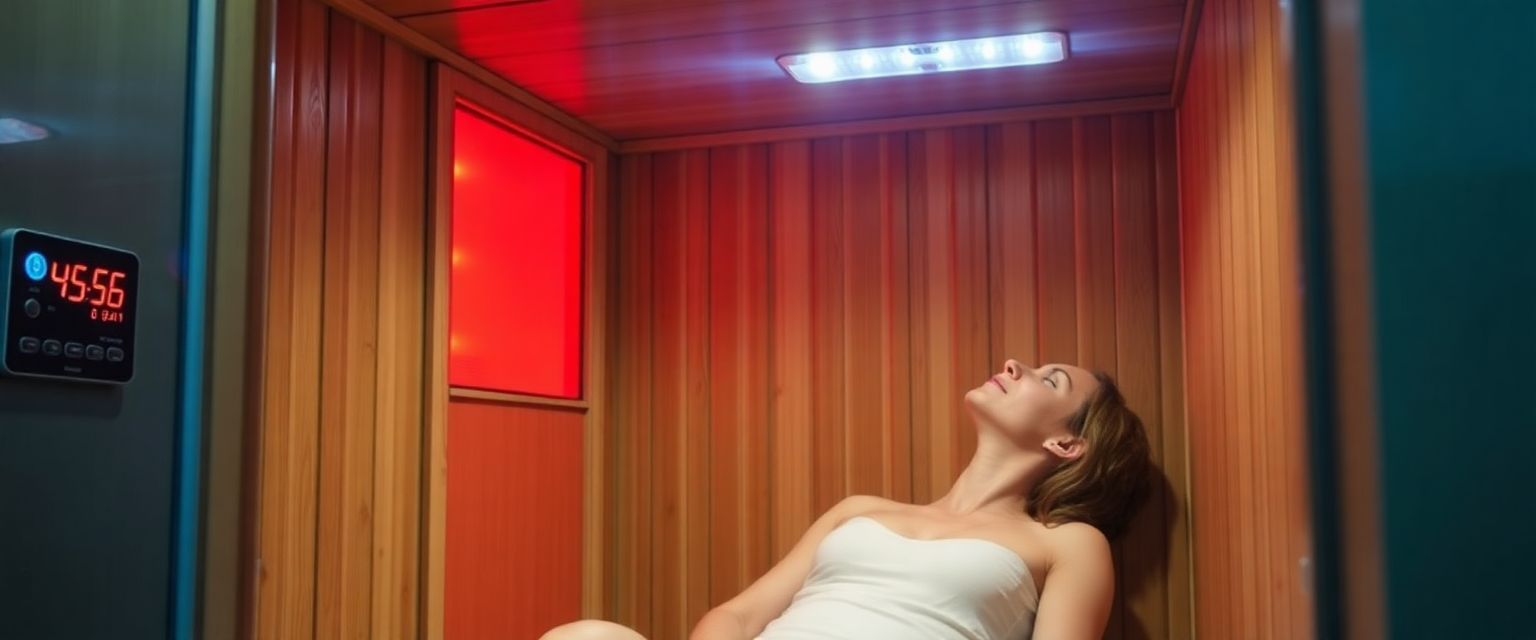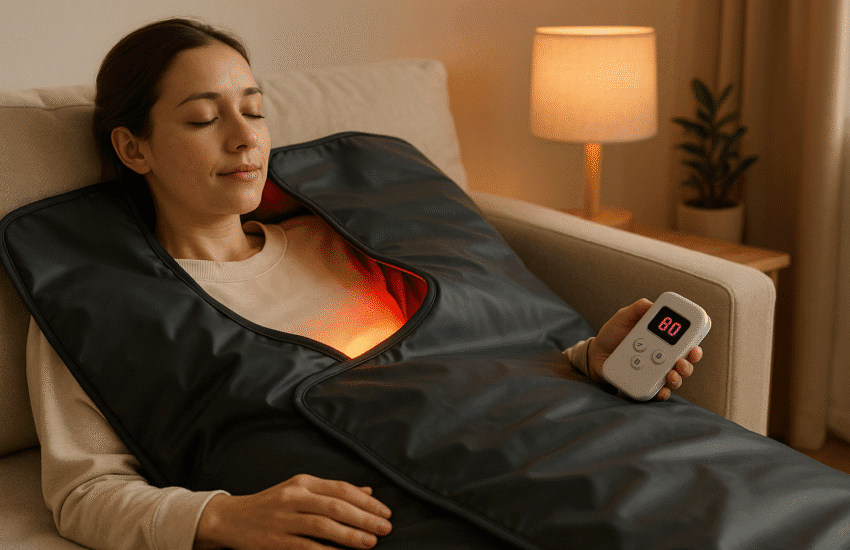How Long to Stay in Infrared Sauna: Finding Your Ideal Session Duration
Determining how long to stay in an infrared sauna can make the difference between a rejuvenating experience and an uncomfortable one. Most beginners should limit infrared sauna sessions to 10-15 minutes, while experienced users might safely extend to 20-30 minutes depending on their tolerance and health status.
The ideal sauna duration isn’t one-size-fits-all—it varies based on your experience level, health goals, and how your body responds to heat therapy. Whether you’re using infrared heat for relaxation, pain relief, or detoxification, understanding the right timing helps maximize benefits while ensuring safety.
How Long to Stay in Infrared Sauna: Duration Guide for Beginners
Your first time stepping into an infrared sauna should feel relaxing, not overwhelming. Starting with just 5-10 minutes gives your body the perfect introduction to infrared heat therapy timing without pushing too hard.
During those initial 1-3 sessions, keep it short and sweet. Your body needs time to adapt to how infrared wavelengths penetrate deeper than traditional sauna heat. Think of it as learning to swim—you start in the shallow end before diving into the deep.
After each session, increase your infrared sauna duration for beginners by 5-minute increments. Most people find they can comfortably handle 15-minute sessions by the end of their first week. This gradual infrared sauna session progression lets your cardiovascular system adjust naturally.
Your body knows best when it comes to safe infrared sauna session length. Feeling lightheaded or unusually tired? Step out right away. No guideline beats listening to your own physical signals.
Always remember to keep a water bottle close throughout your session. Proper infrared sauna hydration requirements mean drinking before, during, and after to replace what you’re sweating out.
Optimal Time in Infrared Sauna for Regular Users
Once you’ve built up your infrared sauna tolerance, your sessions can extend to that therapeutic sweet spot of 20-30 minutes. This infrared heat therapy duration gives those healing wavelengths enough time to work their magic on your tissues.
Keep in mind that your daily energy levels affect your ideal session length. Had a rough night’s sleep? Keep it shorter. Feeling great? You might handle the full 30 minutes without issue.
For detoxification purposes, aim for at least 20 minutes in your infrared sauna. This gives your body sufficient time to reach that deep, cleansing sweat that helps eliminate toxins through your pores.
Consider breaking longer sessions into rounds. Step out after 20 minutes, cool down for 5, then return for another stint. This approach makes extended infrared heat exposure more comfortable while maintaining therapeutic benefits.
Regular users often find their perfect rhythm involves consistent timing rather than marathon sessions. Three 25-minute visits weekly typically deliver better results than one exhausting hour-long session.
How Long Should You Stay in Infrared Sauna Based on Health Goals
Different wellness objectives call for different infrared sauna time limits. Just as a quick shower serves a different purpose than a long bath, your session length should match your intended outcome.
- For stress relief and relaxation, 15-20 minutes provides the perfect infrared sauna duration. This window gives your nervous system enough time to shift into that calm, parasympathetic state without overdoing the heat exposure.
- Athletes seeking muscle recovery benefits need 20-30 minute sessions. This infrared sauna time for muscle recovery allows deep tissue penetration, increasing blood flow to sore areas and speeding up the healing process.
- Skin health and detoxification peak during 25-35 minute sessions. This extended infrared sauna duration for skin benefits maximizes sweating, which helps clear pores while boosting circulation to your skin’s surface layers.
- Those using infrared therapy for weight management might aim for 25-40 minutes across multiple weekly sessions. The caloric expenditure increases with time, though this should complement—never replace—regular exercise.
- Evening sessions of 15-20 minutes can improve sleep quality when timed 1-2 hours before bed. This infrared sauna time for sleep improvement helps lower your core temperature afterward, signaling your body to prepare for rest.
Maximum Infrared Sauna Time: Understanding Safety Limits
Even beneficial therapies have upper boundaries. Most manufacturers and health experts cap the maximum infrared sauna time at 45 minutes, regardless of your experience level.
Beyond this infrared sauna safety duration, dehydration risks climb significantly. Your body can only handle so much heat stress before protective mechanisms kick in.
Warning signs of excessive infrared heat exposure include dizziness, nausea, rapid heartbeat, or extreme fatigue. These infrared sauna duration warning signs mean immediate exit—no exceptions.
Special populations need extra caution with timing. Pregnant women, those with cardiovascular conditions, or people on certain medications should limit sessions to 15-20 minutes after consulting their healthcare provider.
Recovery matters as much as the session itself. Your body needs adequate infrared sauna recovery time between sessions—at least 24 hours after intensive heat exposure. This spacing prevents cumulative stress on your system.
What Affects Your Ideal Infrared Sauna Session Length
Personal factors significantly influence how long you can comfortably remain in infrared heat. Understanding these variables helps you customize your perfect session duration.
Hydration status directly impacts your heat tolerance. Well-hydrated bodies regulate temperature more efficiently, potentially allowing longer sessions. Dehydration shortens your safe window considerably.
Fitness level and cardiovascular health affect your infrared sauna endurance building capacity. Those with stronger circulatory systems typically handle extended heat exposure better than sedentary individuals.
Medications can alter your body’s heat response dramatically. Some prescriptions affect sweating ability or heart rate, requiring shorter sessions. Always verify with your doctor if you’re taking any regular medications.
Temperature settings create an inverse relationship with session length. Lower temperatures (110-120°F) permit longer stays than higher settings (130-140°F). This infrared sauna duration and temperature relationship lets you adjust based on comfort and goals.
Time of day influences your experience too. Morning sessions might energize while evening ones relax. Pay attention to these patterns when planning your infrared sauna session scheduling.
Building Your Infrared Sauna Routine: Frequency and Duration
Creating a sustainable practice means finding the right balance between infrared sauna session frequency and duration. Start with 2-3 weekly sessions at whatever length suits your experience level.
Mark these appointments in your calendar just as you would any other wellness activity. Consistency beats intensity when it comes to infrared heat therapy benefits.
Plan for adequate infrared sauna cooldown period after each session. Rushing back to stressful activities diminishes the therapeutic effects. Allow 15-30 minutes for gradual temperature normalization.
Shorter, frequent sessions often yield better results than sporadic long ones. Three 20-minute sessions weekly typically outperform one exhausting hour-long stint in terms of overall benefits.
Track your progress using infrared sauna duration tracking methods. Note how different session lengths affect your energy, sleep quality, or pain levels. This personal data helps fine-tune your ideal timing.
Pre and post-session rituals enhance your results. Hydrate thoroughly beforehand, shower afterward to rinse away toxins, and take time for proper cooldown. These habits maximize every minute spent in infrared heat.
First-Time Infrared Sauna Session Length: Beginner Protocol
New users need special consideration when determining their initial infrared sauna session length. The experience differs from traditional saunas—infrared heat penetrates deeper into your tissues.
Your very first session should last just 5-10 minutes. This brief first-time infrared sauna session length introduces your body to the unique sensation without overwhelming your system.
Set a timer during early sessions. Relaxation can make you lose track of time, but beginners especially need to monitor their infrared sauna duration carefully.
Most newcomers naturally progress to 20-minute sessions within their first month. This infrared sauna gradual increase method respects your body’s adaptation process while building heat tolerance safely.
Hydration becomes crucial for beginners whose bodies haven’t adapted to increased sweating. Drink 16-20 ounces of water before your session and continue hydrating afterward.
Allow extra infrared sauna timing between sessions as a beginner. You might need 48 hours rather than 24 between visits initially. Your body will signal when it’s ready for more frequent exposure.
Pay attention to how you feel during recovery. As your infrared sauna beginner protocol progresses, you’ll notice improved tolerance and faster bounce-back between sessions.
Conclusion
Finding your perfect infrared sauna session length involves balancing therapeutic benefits with personal comfort and safety. Most users discover their ideal duration falls between 20-30 minutes, though beginners should start with just 5-10 minutes and build gradually.
Remember that consistency outweighs duration—regular shorter sessions often deliver better results than occasional lengthy visits. Your body provides the best guidance if you pay attention to its signals.
As you develop your infrared heat therapy routine, adjust timing based on your energy, health goals, and physical response. Your optimal session length may evolve as your body adapts and your wellness objectives change. Individual results vary, so consult a healthcare professional before beginning any new health practice, especially if you have any underlying medical conditions.


